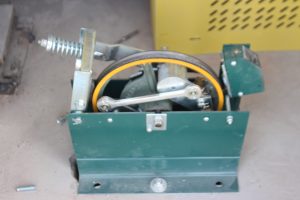
An elevator safety gear is a crucial safety mechanism designed to prevent the elevator car from falling in the event of a malfunction, such as a cable failure or other mechanical issue. It is an essential component of modern elevator systems, ensuring the safety of passengers and preventing accidents during abnormal conditions.
Here’s a detailed description of the Elevator Safety Gear:
Key Features & Functions:
- Emergency Stopping Mechanism:
- The primary function of the elevator safety gear is to stop the car from descending uncontrollably. It engages in emergency situations when the elevator’s speed exceeds a certain limit, usually due to a cable or motor failure.
- Speed Governor:
- The safety gear is typically connected to a speed governor, which continuously monitors the speed of the elevator. If the elevator begins to descend too quickly (usually because of a cable break or malfunction), the governor triggers the safety gear.
- Clamping Action:
- The safety gear works by applying a clamping mechanism to the guide rails inside the elevator shaft. This mechanism is usually composed of two or more brake shoes that are triggered by the speed governor. These brake shoes clamp tightly onto the guide rails, creating friction to stop the elevator car’s movement quickly but safely.
- Activation and Deactivation:
- Safety gears are usually designed to activate only in extreme conditions, such as when the elevator car’s speed surpasses a predetermined threshold (typically due to free fall or rapid descent). Once engaged, the safety gear will stop the car and keep it securely in place.
- In some cases, the gear may need to be manually reset after activation.
- Mechanical or Electromechanical Design:
- Mechanical Safety Gear: This type uses a physical mechanism, such as spring-loaded brake shoes or cams, to engage with the guide rails when triggered by the speed governor.
- Electromechanical Safety Gear: In more advanced systems, electronic sensors and controls are used to activate the safety gear, allowing for more precise and responsive operation.
- Multi-Stage Operation:
- Some safety gears have multi-stage operation, meaning they apply different levels of braking force depending on the severity of the situation. For example, the first stage might gently slow down the car, while a second, more forceful stage brings it to a complete stop if necessary.
- Automatic Reset:
- In some modern elevator systems, the safety gear is designed to reset automatically once the car is safely stopped and the system is restored to normal operation. In others, manual intervention may be required to reset the system after an emergency activation.
Importance of Elevator Safety Gear:
- Passenger Safety: The safety gear is a life-saving feature that ensures the elevator car doesn’t fall or descend uncontrollably, protecting passengers from injury or harm.
- Compliance with Standards: Modern elevators are required by various international safety codes and regulations (such as EN 81-20, ASME A17.1, etc.) to include a safety gear mechanism to comply with safety standards.
- Reduces Risk of Accidents: It is particularly crucial in preventing accidents due to mechanical failures, such as broken cables, and offers peace of mind to users.
- Reliable Functionality: The gear ensures that even in the worst-case scenario, the lift will not free-fall and will instead stop safely, preventing a catastrophic event.
Types of Safety Gears:
- Rope or Cable-Operated Safety Gear: This type is commonly used in traction elevators, where the safety gear is engaged through the loss or rapid descent of the cables.
- Hydraulic Safety Gear: Used in hydraulic elevators, where the safety mechanism often involves a braking system that engages when pressure loss occurs in the hydraulic system.
Maintenance & Testing:
- Elevator safety gears require regular maintenance and testing to ensure they function properly. Inspections are often done during routine service visits, where the system is tested for speed regulation, braking force, and responsiveness to emergency conditions.
Conclusion:
The elevator safety gear is a vital safety feature that prevents catastrophic accidents, offering protection to passengers by preventing free falls or rapid descents. It’s a highly reliable, mechanical or electromechanical system that is essential for modern elevators, providing an added layer of safety during unforeseen failures.
Let me know if you’d like more technical details or examples of specific safety gear models!
